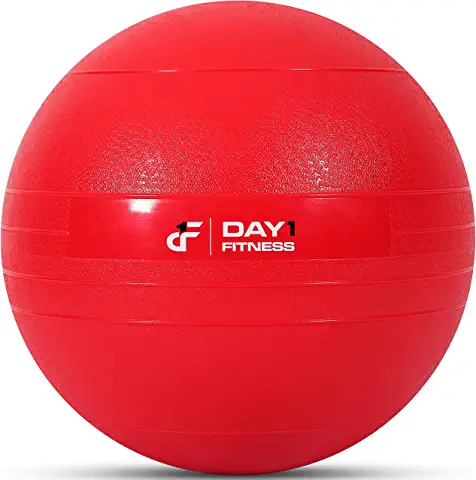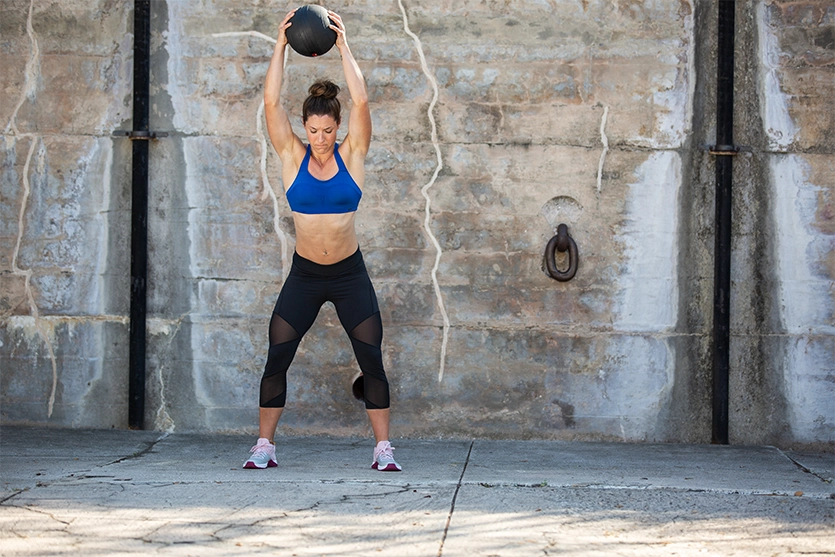Required Equipment: A slam ball
Introduction
A kissing cousin to medicine balls (that’s just a phrase, West Virginians…calm down), slam balls are made for one thing: to be slammed. Walloped. Bludgeoned. Hurled. Smashed. Banged. 1not like that, sicko. Anyways, you get the idea. If not, you might 2be a moron want to stop reading now as it only gets more difficult from here out.
Where was I? Oh yeah. While they’re not essential, slam balls are a great piece of equipment to have in your home gym. Not only are they fun, they can help you work out the day’s stresses all while improving your strength and conditioning.

Slam balls are also great for improving your speed and/or power, and can be used target specific body parts like your abs or shoulders. Below I’ll go over what a slam ball is, when to use one, what to do look for when buying one, and how to choose the best one for you.
So if you want to know more about these versatile pieces of equipment then keep reading!
What is a slam ball?

Slam balls are a type of weighted ball that has been specifically designed to withstand the rigors of slamming, dropping, and throwing.
While they are sometimes confused with wall balls or medicine balls, they are actually a different product. They are typically heavier than other weighted balls although lighter slam balls – as light as 6 lbs. – are available.
In contrast to a medicine ball, a slam ball does not rebound off an object, such as a floor or wall. Instead, they function as “dead weight” after they’re thrown. This is what makes them ideal for actual slamming.
After all, if you were to do the same thing with a medicine ball, the rebound could very easily injure you or an unsuspected person. Basically every exercise you can do with a medicine ball, you can also do with a slam ball.
What is a slam ball made of?
Slam balls are (typically) made of a outer shell of durable rubber material and an durable inner shell typically filled with sand or rubber. The durability of a slam ball is what makes them perfect for use outdoors or in the gym, as well as for a variety of different exercises.

Anyways, as you slam the ball, the material inside the shell moves around giving the ball a bit of unpredictability. That unpredictability can make them a bit difficult to catch as compared to a wall ball or medicine ball.
Many slam balls also have some sort of texture on the outside. This helps with your ability to grip the ball – whether picking it up off the floor or throwing or catching the ball. While the design and amount of texture varies, I prefer a ball with more rather than less. I find it helps when using a slam ball as more complex movements tend to require more grip.
Why should I use a slam ball?
Like I mentioned above, I don’t think it’s a necessary piece of fitness equipment. For that, stick with a weight bench, some dumbbells, and maybe a squat rack.
But like any other equipment, the slam ball is a tool to be used in specific scenarios. And since not every tool is useful in every situation let’s define when you should use one. In my mind, a slam ball is an ideal piece of equipment to focus on two things:
- Rotation
- Power development
Let’s take a closer look at what this means…
Rotational Exercises With Slam Balls
One movement where a medicine ball or slam ball shines is rotation. Not only are rotational movement underworked by the vast majority of people, a ball makes the movement much more natural to perform.
Rotational movements really focus on training your core strength. And core strength is important in real life – think preventing lower back pain – as well as in athletic performance and sports.

Do you like to swing a golf club? Throw a few punches on the heavy bag? Play baseball? Spike a volleyball? All those heavily involve your core 3which includes your lower back and to be efficient and strong in those movements, you need to train it.
For example, doing a one-armed throw (from both sides) can not only improve your perform, but can balance out your body as you equally work each side. A standing slam ball wall toss can develop full-body power in the transverse and frontal planes.
Speaking of power, let’s look at the second major reason to use a slam ball.
Power Development with Slam Balls
If you’re a regular reader of the blog and – thanks Mom! – you’d have noticed I like to talk about power (or work) and the physics of it. Yes, physics, that boring high school class you fell asleep in 4sorry, Mr. Bolton!. So bear with me for a few moments.
Anyways, let’s define it:

- Power= (Force * Distance) divided by time. And force equals mass times acceleration. So, P= (mass * acceleration * distance) divided by time.
Still with me? And how does this translate to using a ball?
Well, in order to create power we have to maximize the top part of the equation and minimize the bottom (time) part. In terms of exercise, safely maximizing acceleration and distance and minimizing time can be done by throwing objects.
Can you it be done with a barbell? Well, you don’t (obviously!) want to throw a barbell or kettlebell or similar tool. But you can develop power (sometimes called rate of force development or how fast you can generate force) using that workout equipment, specifically when doing Olympic lifts.

The question, though, is can you do it safely and consistently? Yeah, go ahead and do that barbell snatch you’ve never practiced and don’t have the mobility for. I guarantee you’ll eventually get hurt doing that 5looking at you, CrossFit, Mr. Weekend Warrior.
The ball allows you to exercise safely as the force it puts back on you is fairly self-limiting. Meaning, I can only throw the ball so hard at a time and I let go of it in order to throw it. If I use a heavier ball – guess what? – my ability to throw it decreases. And since there’s no rebound, I’m kept relatively safe when using it.
So, yes, there are other ways to safely work on your rate of force development – such as plyometrics or trap bar jumps – but almost everyone is familiar with throwing a ball. Not only is it easier to learn, it’s easier to do and safer to boot. Slam ball exercises can be performed by younger, older, and advanced athletes pretty effectively.
So what are some examples?
- Overhead Slams: simply bring the ball overhead and slam it into the ground as quickly as possible.
- Squat to overhead throw: perform a squat while holding the ball in front of your body and push or throw the ball overhead as high as possible 6 be sure to get out of the way or you might end up brain damaged, like Bernie supportersyou reach the top part of your squat position.
- Chest Passes: Grab the ball with both hands and throw it above your head, simulating a chest pass in basketball or football. You can do this move from either side of your body.
- Rotational throws: There are a myriad of exercises where you can rotate with the ball; in doing so, you’ll build your core strength.
There’s a lot of exercises you can do that can your upper body, lower body, and core muscles all at the same time. While it’s not something I normally do, you can even get an effective entire body workout just using slam ball exercises.
When and how should I use a slam ball in my workout?
In terms of your programming, if you’re looking add some slam ball exercises, I’d prioritize using the slam ball at beginning of your workout routine. This ensures you’re fresh, clear-headed, and have enough energy to do the exercises powerfully.

Also, keep the sets and reps relatively low. You’re trying to generate maximal force over a large distance and you need to be explosive (and coordinated) in order to do so. If you’re get too tired, it becomes very difficult to do that successfully.
After you’ve done your ball slam exercises, then move on to strength training.
What Slam Ball Should I Buy?
Slam balls come in a variety of sizes and weights, so choose the one that is right for your fitness level. They are also available in different colors, so you can choose one that matches your personality or décor 7very important.
While durability is a concern, most reputable manufacturers are going to make a good product. Really, the most important factor in buying a slam ball is determining how heavy it should be.
Since they come in many weights – ranging from light to heavy – it’s important to find one that fits your strength level yet still provides challenge. While there are many variables (such as which exercises you’re going to perform with them), here’s a good rule of thumb as to to weight you should buy:

- Beginners or Youth – 8 lbs. to 15 lbs. is the optimal range. I would start youths on the lower end of that scale and incrementally progress to heavier slam balls as they get stronger.
- Intermediate – 20 lbs. to 35 lbs. is going to be pretty challenging for most folks.
- Advanced – 40 lbs. and up.
Lastly but not least, make sure you choose a slam ball with good grip! A good grip allows you to hold your slam ball more easily when throwing it up into the air or slamming it on the ground! It also helps prevent blisters from forming and minimizes the chances of any errant throws…
To summarize:
- Buy the right size / weight for your needs.
- Look for a ball that is durable and can be used outdoors or in the gym.
- Make sure it has a good grip
- Look for a one with good reviews
DIY (make your own) slam ball
If you want to make your own slam ball, there are a couple of different approaches both of which are very easy.
- Grab a basketball or a canvas bag
- Separately, grab a trash bag (or two) and fill them with sand. Wrap your bag/s in duct tape so no sand can escape.
- Insert the filled bag/s into your bag or basketball.
- Use duct tape or gorilla tape to wrap the outside of your bag or ball. If you use a bag, try to give it a circular shape to mimic a ball.
That’s it. And, yes, this is super simple but it doesn’t have to be complex to be effective.
You can skip step 2 if you want although I think it’s good to have another layer of support so the sand doesn’t leak. If you want to see a homemade one in action, you can see this page.
Conclusion
Slam balls are a great addition to any fitness enthusiast’s arsenal. They can be used for to build coordination, purposeful power and rotational development, and are a fun way to perform complex movements. It’s also a fun way to work out some aggression while getting fit.
Since slam balls are durable, they’re perfect for training outside or in the gym and for a variety of exercises and workouts – the possibilities are endless 8 not literally but I like the phrase!
That’s it! Now that you have learned all about the benefits of slam balls and why and when to use one, I hope that you’ll give it a try.
What’s the difference between a medicine ball and a slam ball?
Many med balls are made of leather, rubber, vinyl or plastic and typically have a softer outer shell. They are not designed to be repeatedly thrown as they can potentially bounce back or break.
Slam balls, on the other hand, are made of harder, durable rubber material and do not bounce. They are designed to be thrown as they won’t bounce back or break when thrown. Slam balls are versatile and can be used for most medicine ball exercises.
What’s the difference between a wall ball and a slam ball?

Wall balls are also used in throwing exercises but should only be thrown at a wall. Walls balls are fairly durable and are much larger than slam balls albeit much softer. They are not designed to be thrown or slammed against the floor nor do they typically weight as much as the largest slam balls.
What’s the difference between a d-ball and slam ball?
None; d-balls are simply another name for a slam ball. And, a slam ball as we all (now) know are great speed, power, and overall fitness.
How heavy of a slam ball should i get?
There are lot of variables in determining the best size and weight but a good rule of thumb is: 15 lbs. or under for beginners, 20lbs to 35 lbs. for intermediate lifters, and 40 lbs. and up for more advanced athletes.







